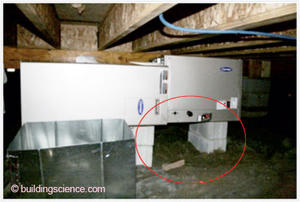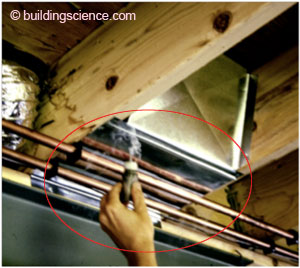This article addresses the issue of unsealed conditioning equipment and ducts located outside the conditioned space in a vented attic, unconditioned crawlspace or basement resulting in risks such as contaminants and moisture being drawn into the conditioning equipment and distributed to the building. Corrective measures are also suggested.

HVAC equipment for house in North Carolina installed in a vented crawlspace over top of damp sand; this is not recommended for various energy, moisture and interior air quality reasons.

Leaky return plenum drawing in trace smoke during the field investigation; the system was negatively pressurized enough to backdraft the combustion air from water heater.
Issue
Unsealed conditioning equipment and ducts located outside the conditioned space in a vented attic, unconditioned crawlspace or basement.
Description of Implementation Error
Conditioning equipment installed in an unconditioned crawlspace (in the example photos) in combination with unsealed returns in the joist spaces.
Risks
Installing conditioning equipment in an unconditioned crawlspace or ventilated attic, in combination with unsealed returns in the joist spaces could result in contaminants and moisture being drawn into the conditioning equipment and distributed to the building. In combination with return plenums in floor joists and wall cavities, it is not uncommon for the space conditioning equipment to be unsealed and draw in air from the surrounding environment. During a field investigation it was found that the unsealed return negatively pressurized the basement enough to backdraft combustion air from the water heater. It should be noted that in this case there was a combustion air makeup supply installed as per the building code, but that this makeup air was not enough to overcome the negative pressurization caused by leaky ductwork.
Required Corrections
Only fully-ducted and sealed returns should be used but it is also important that the air conditioning equipment should also be sealed, especially when located in a vented crawlspace or attic. Air sealing should ideally be done with mastic, or (second choice) tape meeting UL 181A or 181B.1 Pressure testing of the entire ducting system and conditioning equipment will determine the amount and location of air leakage with a fan and manometer.
Footnote
